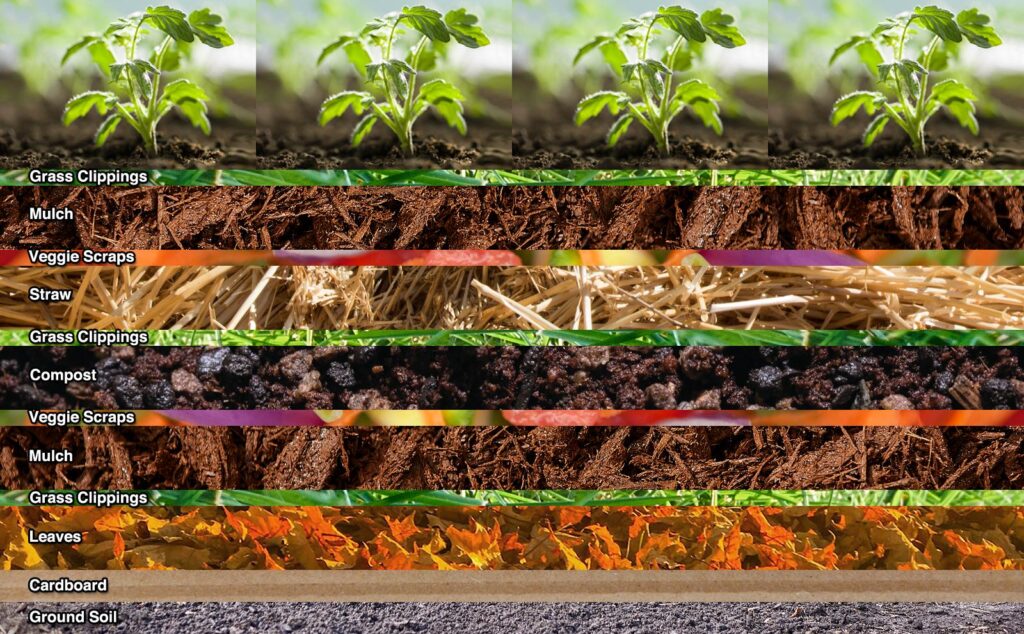If you’ve been dreaming of having your own vegetable garden but have an empty grass backyard, don’t worry! With the No-Dig Method by Charles Dowding, you can turn your lawn into a green vegetable heaven. This gardening technique, based on layering material instead of tilling or loosening the soil. The idea is that you’re leaving the microbes and soil ecosystem undisturbed. Here are some actionable steps to help you get started with your no-dig garden:
Step 1: Preparation
The first step in transforming your lawn into a vegetable garden is to prepare the area. Start by mowing the grass as short as possible and removing any debris or rocks. Then, cover the entire lawn with a layer of cardboard or thick newspaper. This will act as a natural weed barrier, preventing grass and weeds from growing through your garden bed.
Step 2: Layout and Inter-Planting
Next, plan the layout of your vegetable garden. Consider the size and shape of your backyard, as well as the amount of sunlight it receives throughout the day. Choose a sunny spot for your garden, as most vegetables require at least 6-8 hours of sunlight per day. You can create raised beds or simply plant directly on top of the cardboard or newspaper layer.
One key principle of the No-Dig Method is inter-planting, which involves planting different crops close together to maximize space and time. For example, you can plant fast-growing crops, such as lettuce or radishes, between slower-growing crops, like tomatoes or peppers. This way, you can make the most of your garden bed and increase your overall yield.
Step 3: Composting
Composting is an important aspect of the No-Dig Method, as it helps enrich the soil and provide essential nutrients to your plants. You can create your own compost by collecting kitchen scraps, yard waste, and other organic materials. Layer the compost on top of the cardboard or newspaper, along with other organic materials such as grass clippings, leaves, and bark mulch. This will help keep the soil moist and promote healthy microbial activity.
You can also use specific composting techniques, such as lasagna gardening or Bokashi composting, to further enhance the nutrient cycle in your garden. Lasagna gardening involves layering different organic materials, such as cardboard, grass clippings, and leaves, to create a rich, nutrient-dense soil. Bokashi composting, on the other hand, uses beneficial microorganisms to break down organic matter quickly and provide extra nutrients to the plants.
Step 4: Planting and Maintenance
Once your garden bed is prepared and composted, it’s time to start planting! Choose vegetable varieties that are suitable for your region and climate. Consider factors such as cold tolerance and maturity time to ensure a successful harvest. Plant your seeds or seedlings according to the recommended spacing and depth for each vegetable.
To maintain your vegetable garden, be sure to water regularly, keeping the soil consistently moist but not waterlogged. Mulching with bark mulch or straw can help retain moisture and suppress weeds. Additionally, consider using crushed eggshells around your plants to deter snails and provide a natural source of calcium.
As your plants grow, provide support such as stakes or trellises for taller crops like tomatoes or beans. Regularly remove any weeds or diseased plants to prevent them from competing with your vegetables for nutrients and sunlight. Consider using techniques such as breaking off side branches or trench composting to further optimize plant growth and yield.
Step 5: Harvesting and Storage
The moment you’ve been waiting for – harvesting your own homegrown vegetables! Harvest your vegetables when they are at their peak of ripeness for the best flavor and nutrition. Store your harvested vegetables properly, following recommended guidelines for each crop. Some vegetables can be stored in a cool, dark place, such as a root cellar or a refrigerator, while others may need to be canned, frozen, or dried for long-term storage. Be sure to properly clean and prepare your vegetables before storing or consuming them to ensure food safety.
Step 6: Continuous Improvement
Gardening is a continuous process, and there’s always room for improvement. Take note of what worked well in your vegetable garden and what didn’t, and make adjustments accordingly. Consider rotating your crops each season to prevent soil depletion and pest infestations. Keep learning and experimenting with different techniques, such as companion planting, crop rotation, and natural pest control methods, to optimize the health and productivity of your vegetable garden.
Remember to take care of your soil by adding organic matter regularly, avoiding the use of harmful chemicals, and promoting biodiversity. Healthy soil is the foundation of a thriving vegetable garden, and the No-Dig Method emphasizes building and maintaining fertile, nutrient-rich soil for sustainable gardening practices.

